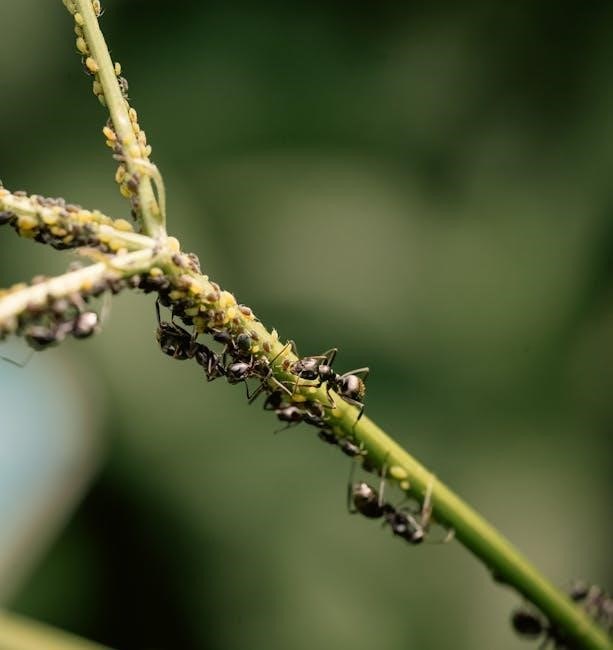Biogeochemical cycles are pathways that transfer essential nutrients like carbon, nitrogen, phosphorus, and water between the biosphere, geosphere, hydrosphere, and atmosphere, sustaining life and regulating Earth’s systems.
1.1 Definition and Overview
Biogeochemical cycles refer to the pathways through which essential nutrients and elements, such as carbon, nitrogen, phosphorus, and water, circulate between the biosphere, geosphere, hydrosphere, and atmosphere. These cycles ensure the continuous exchange of materials, supporting life and maintaining the balance of Earth’s ecosystems and climate systems.
1.2 Importance in Ecosystems
Biogeochemical cycles are essential for sustaining life, as they regulate the flow of nutrients and energy through ecosystems. They support plant growth, maintain water quality, and influence Earth’s climate, ensuring the availability of resources for all organisms. These cycles are fundamental for biodiversity and the overall health of ecosystems, connecting living and non-living components.
Major Biogeochemical Cycles
Major biogeochemical cycles include carbon, nitrogen, phosphorus, and water cycles, essential for nutrient circulation and energy flow across ecosystems.
2.1 Carbon Cycle
The carbon cycle involves the movement of carbon between reservoirs: atmosphere, biosphere, hydrosphere, and lithosphere. Key processes include photosynthesis, respiration, decomposition, and fossil fuel combustion. Carbon is stored in organic matter, carbonate rocks, and dissolved inorganic carbon in oceans. Human activities, like burning fossil fuels, significantly impact carbon flow, leading to climate change and ecosystem disruptions.
2.2 Nitrogen Cycle
The nitrogen cycle involves processes like nitrogen fixation, ammonification, nitrification, and denitrification, circulating nitrogen through ecosystems. Nitrogen is essential for amino acids, DNA, and plant growth. Human activities, such as fertilizer use, disrupt this cycle, causing environmental issues like water pollution and loss of biodiversity, underscoring the need for sustainable practices to maintain ecological balance.
2.3 Phosphorus Cycle
The phosphorus cycle is a slow, sedimentary process involving the movement of phosphorus through rocks, water, and organisms. It’s essential for DNA, RNA, and ATP production. Unlike other cycles, phosphorus doesn’t have a gas phase, making it reliant on weathering and erosion. Its availability often limits ecosystem productivity, particularly in aquatic environments, where excess can cause algal blooms and water quality issues.
2.4 Water Cycle
The water cycle involves continuous movement of water between Earth’s systems through evaporation, condensation, and precipitation; It sustains life by distributing freshwater, regulating climate, and connecting oceans, atmosphere, and land. This cycle is vital for nutrient transport and energy balance, ensuring ecosystems function smoothly and supporting agriculture and human activities globally. Its integrity is crucial for environmental health and biodiversity preservation.
Processes in Biogeochemical Cycles
Biogeochemical cycles involve processes like photosynthesis, respiration, and decomposition, which transfer nutrients and energy between organisms and the environment, sustaining ecosystem balance and supporting life.
3.1 Photosynthesis and Respiration
Photosynthesis and respiration are vital processes in biogeochemical cycles, transferring carbon dioxide and oxygen between organisms and the atmosphere. Photosynthesis converts sunlight into energy, capturing CO2 and releasing O2, while respiration breaks down organic matter, releasing stored energy and CO2 back into the environment, maintaining the carbon cycle’s balance and supporting life on Earth.
3.2 Decomposition and Nutrient Release
Decomposition is the breakdown of organic matter by microorganisms, releasing nutrients like carbon, nitrogen, and phosphorus back into ecosystems. This process is crucial for nutrient cycling, as it converts complex molecules into forms usable by plants and other organisms, maintaining soil fertility and supporting biodiversity across terrestrial and aquatic environments.
3.4 Human Impact on Nutrient Cycles
Human activities, such as agriculture, fossil fuel combustion, and pollution, significantly disrupt biogeochemical cycles. Excess nitrogen and phosphorus from fertilizers cause eutrophication in water bodies, while carbon emissions accelerate climate change. These disruptions alter ecosystems, reduce biodiversity, and threaten global food security, necessitating sustainable practices to restore nutrient balance and mitigate environmental damage.

Reservoirs and Pathways
Reservoirs, such as the atmosphere, hydrosphere, lithosphere, and biosphere, store nutrients. Pathways like diffusion, precipitation, and biological processes transfer these nutrients, maintaining the balance of biogeochemical cycles.
4.1 Atmosphere, Hydrosphere, Lithosphere, and Biosphere
The atmosphere holds gases like carbon dioxide and oxygen, while the hydrosphere includes oceans and water bodies. The lithosphere encompasses rocks and soil, storing minerals and nutrients. The biosphere, where life resides, interacts with these reservoirs, facilitating nutrient exchange and cycling through ecosystems, essential for sustaining life and regulating Earth’s systems effectively.
4.2 Exchange of Nutrients Between Reservoirs
Nutrients circulate between the atmosphere, hydrosphere, lithosphere, and biosphere through processes like evaporation, precipitation, and decomposition. Plants absorb nutrients from soil, transferring them to the biosphere, while decomposition returns them to the lithosphere. This continuous exchange ensures nutrient availability, maintaining ecological balance and supporting life across Earth’s interconnected systems.
The Carbon Cycle in Detail
The carbon cycle involves the movement of carbon between the atmosphere, oceans, soil, and living organisms through processes like photosynthesis, respiration, and decomposition, regulating Earth’s climate and storing carbon in fossil fuels and organic matter.
5.1 Sources and Sinks of Carbon
Carbon sources include fossil fuel combustion, deforestation, and respiration, releasing CO2 into the atmosphere. Sinks, such as forests, oceans, and soil, absorb carbon through photosynthesis and chemical reactions, balancing the cycle and mitigating climate change by storing carbon in biomass, sediments, and dissolved inorganic forms.
5.2 Impact of Human Activities
Human activities, such as fossil fuel combustion, deforestation, and land-use changes, significantly alter the carbon cycle, increasing atmospheric CO2 levels. These actions accelerate global warming and climate change, disrupting natural carbon sinks and exacerbating extreme weather events. Sustainable practices are essential to mitigate these impacts and restore balance to the carbon cycle.

The Nitrogen Cycle in Detail
The nitrogen cycle involves the conversion of nitrogen into various forms, essential for plant growth and life. It includes fixation, nitrification, and denitrification, sustaining ecosystems globally.
6.1 Nitrogen Fixation and Denitrification
Nitrogen fixation converts atmospheric nitrogen into ammonia, essential for plant uptake, while denitrification returns it to the atmosphere. These processes regulate nitrogen availability, critical for ecosystem balance and productivity, ensuring proper nutrient cycling and sustaining life.
6.2 Role in Plant Nutrition
Nitrogen is essential for plant growth, forming proteins, nucleic acids, and chlorophyll. Plants absorb it as nitrates or ammonia, driving photosynthesis and productivity. Nitrogen deficiency stunts growth, while excess leads to environmental pollution, highlighting the need for balanced nutrient management to optimize crop yields and ecosystem health.

The Phosphorus Cycle in Detail
Phosphorus cycles through ecosystems, primarily in sedimentary rocks, with slow movement driven by weathering and decomposition. It is vital for biomolecules like DNA and ATP, supporting plant growth and energy transfer in organisms, while excess runoff can disrupt aquatic ecosystems.
7.1 Sedimentary Cycle Characteristics
The phosphorus cycle is primarily sedimentary, with most phosphorus stored in rocks. Weathering releases it into soil, where plants absorb it. Phosphorus then enters the food chain through herbivores and carnivores, returning to the soil via decomposition. Human activities like mining and agriculture disrupt this cycle, leading to nutrient imbalances and environmental impacts. Sedimentary cycles are slower and more localized than gaseous cycles.
7.2 Importance in Aquatic Ecosystems
Phosphorus is essential for aquatic ecosystems, supporting algae growth and aquatic plant production. It fuels the food web, from phytoplankton to fish, and sustains biodiversity. Excess phosphorus, however, can cause eutrophication, leading to algal blooms and oxygen depletion. Balancing phosphorus levels is critical for maintaining water quality and aquatic life, as its cycling directly impacts ecosystem health and productivity in freshwater and marine environments.

The Water Cycle in Detail
The water cycle involves evaporation, condensation, and precipitation, circulating water between oceans, atmosphere, and land. It regulates Earth’s climate, sustains life, and connects biogeochemical systems globally;
8.1 Evaporation, Condensation, and Precipitation
Evaporation transforms water from oceans and land into vapor, rising into the atmosphere. Condensation cools this vapor, forming clouds. Precipitation occurs when water droplets in clouds condense and fall as rain, snow, or hail, replenishing Earth’s surface and maintaining the hydrological balance essential for life and ecosystems.
8.2 Role in Global Climate Regulation
The water cycle plays a crucial role in regulating Earth’s climate by redistributing heat globally. Evaporation cools surfaces, while precipitation releases heat, influencing weather patterns and climate systems. This process moderates temperatures, drives atmospheric circulation, and balances greenhouse gases, maintaining climatic stability essential for life and ecosystem functioning.
Biogeochemical Cycles and Ecosystem Health
Biogeochemical cycles ensure nutrient availability, sustaining ecosystem productivity. Imbalances disrupt habitats, affecting biodiversity and ecological stability, highlighting the critical role of these cycles in maintaining healthy, functioning ecosystems.
9.1 Nutrient Limitation and Ecosystem Productivity
Nutrient availability drives ecosystem productivity, with elements like nitrogen and phosphorus often limiting plant growth. These nutrients, cycled through biogeochemical processes, regulate photosynthesis and biomass production. Imbalances or deficiencies can constrain ecosystem functioning, highlighting the critical role of nutrient cycling in sustaining healthy, productive environments and maintaining biodiversity. Proper nutrient balance ensures optimal ecological performance and stability.
9.2 Consequences of Imbalances
Imbalances in biogeochemical cycles disrupt ecosystem functioning, leading to cascading effects such as eutrophication, biodiversity loss, and altered carbon sequestration. Excess nutrients can cause algal blooms and oxygen depletion, while deficiencies limit plant growth. Such disruptions often stem from human activities, highlighting the need for sustainable management to restore equilibrium and maintain ecosystem health and resilience over time.
Human Influence on Biogeochemical Cycles
Human activities, such as burning fossil fuels, deforestation, and fertilizer use, significantly alter biogeochemical cycles, releasing excess carbon dioxide, nitrous oxide, and nutrients, leading to environmental imbalances and climate change.
10.1 Fertilizers and Pollution
Fertilizers release excess nutrients like nitrogen and phosphorus into ecosystems, causing eutrophication in water bodies. This leads to algal blooms, depletes oxygen, and harms aquatic life, disrupting biodiversity and ecosystem balance. Additionally, nitrates leach into groundwater, polluting drinking water sources and posing health risks to humans and wildlife.
10.2 Climate Change Effects
Climate change disrupts biogeochemical cycles by altering temperature and precipitation patterns, affecting carbon sequestration and nutrient availability. Rising atmospheric CO2 levels enhance plant growth but may disrupt nitrogen cycling, leading to ecosystem imbalances. Warmer temperatures accelerate decomposition, releasing stored carbon and exacerbating greenhouse gas emissions, further intensifying climate change impacts on global nutrient distributions and biodiversity.
Biogeochemical Cycles and Microbiology
Microorganisms play a vital role in biogeochemical cycles by facilitating nutrient transformations. Bacteria and fungi drive decomposition, nitrogen fixation, and carbon cycling, enabling nutrient reuse and sustaining ecosystem health.
11.1 Microbial Roles in Nutrient Cycling
Microorganisms are central to nutrient cycling, decomposing organic matter, releasing essential nutrients, and facilitating processes like nitrogen fixation. Specific bacteria convert atmospheric nitrogen into forms usable by plants, while others break down organic carbon, enriching ecosystems and promoting plant growth.
11.2 Symbiotic Relationships
Symbiotic relationships, like mycorrhizal associations between fungi and plant roots, enhance nutrient exchange, improving phosphorus uptake. Similarly, nitrogen-fixing bacteria in legume roots convert atmospheric nitrogen into plant-accessible forms, exemplifying mutualistic partnerships that optimize nutrient cycling in ecosystems.
Case Studies and Examples
The Amazon Rainforest exemplifies carbon sequestration, while agricultural systems highlight nitrogen cycle disruptions, offering insights into ecosystem management and sustainability through practical examples.
12.1 The Amazon Rainforest and Carbon Sequestration
The Amazon Rainforest plays a critical role in the carbon cycle, absorbing significant CO2 through photosynthesis, storing it in biomass and soil, thus mitigating climate change. Deforestation disrupts this process, releasing stored carbon and reducing sequestration capacity, emphasizing the need for conservation efforts to preserve this vital carbon sink and global climate regulator.
12.2 Nitrogen Cycle Disruption in Agricultural Systems
Agricultural practices, such as heavy fertilizer use and monoculture farming, disrupt the nitrogen cycle by releasing excess nitrogen into ecosystems. This leads to eutrophication in water bodies, soil degradation, and loss of biodiversity. Excess nitrogen also contributes to greenhouse gas emissions, particularly nitrous oxide, further exacerbating climate change and highlighting the need for sustainable farming practices to restore nitrogen balance.
Managing biogeochemical cycles is crucial for sustainability, requiring balanced practices to mitigate disruptions. Future research and conservation efforts must focus on restoring equilibrium and promoting eco-friendly strategies to ensure planetary health and resilience.
13.1 Managing Biogeochemical Cycles for Sustainability
Sustainable management of biogeochemical cycles involves balancing nutrient flows to avoid ecological disruptions. Practices like reducing fertilizer use, enhancing carbon sequestration, and protecting natural habitats can mitigate human impacts. Implementing policies that promote eco-friendly agriculture and conservation will help maintain the integrity of these cycles, ensuring long-term environmental health and resource availability for future generations.
13.2 Research and Conservation Efforts
Research focuses on understanding biogeochemical cycles to address environmental challenges. Conservation efforts include restoring ecosystems, monitoring nutrient flows, and developing sustainable practices. Collaborative initiatives between scientists, policymakers, and communities are crucial for protecting these cycles and ensuring a balanced, healthy planet for future generations.
